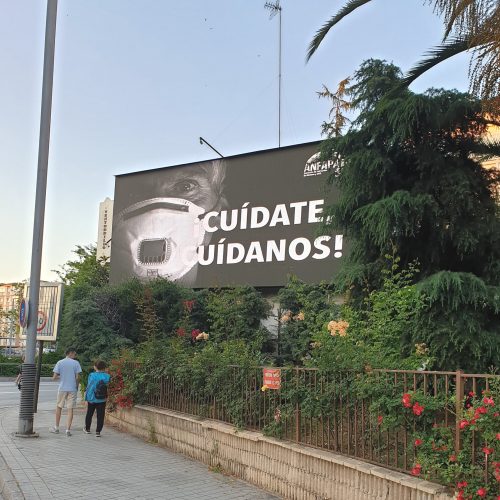
Understanding Spain’s Policy on Coronavirus
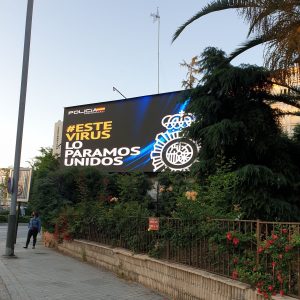 Dear Kim,
Dear Kim,
Life during the Coronavirus pandemic has been confusing. There seem to be different policies in place in every country (if not every region of every country) and so it’s difficult to know what rules are in place anywhere, especially if you are not currently living in the country. You may know that Spain has recently opened up to international tourism. For this reason, we believe it is important to inform you about Spain’s policy in terms of dealing with COVID-19 so that you can make an informed decision about visiting. We will get into the specifics of health and safety precautions being taken in terms of travel in Thursday’s post but for today let’s look at what Spain’s approach to the pandemic has been and what things look like today.
The “Four Phase De-escalation Plan” explained
Dani mentioned in the post about her personal experience living in Spain under lockdown that the “Four Phase De-escalation Plan” feels like it has actually had five phases, but let’s explore—very briefly—what that has meant. We say ‘very briefly’ as the rules in place during each phase have changed so specifically that there is a 20+ page-long explanation for each and every phase!
While we will link to those resources (which are in Spanish) we will attempt to highlight the most important rules for each phase. Keep in mind that each province has been required to remain in Phase One through Three for at least two weeks* apiece, longer if they have not met the requirements (based on the number of new cases of COVID-19).
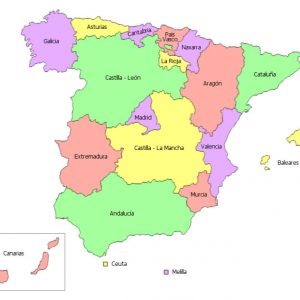 In this sense, Spain has taken a very ‘regionalized’ approach to de-escalating the spread of Coronavirus. This could be the reason you have heard conflicting information if you speak to people or read about the current circumstances in different regions of Spain. The country has not made changes in a unified way, but instead poco a poco to ensure that each area is genuinely ready to continue on from the strict quarantine that proceeded this plan.
In this sense, Spain has taken a very ‘regionalized’ approach to de-escalating the spread of Coronavirus. This could be the reason you have heard conflicting information if you speak to people or read about the current circumstances in different regions of Spain. The country has not made changes in a unified way, but instead poco a poco to ensure that each area is genuinely ready to continue on from the strict quarantine that proceeded this plan.
Phase Zero
This phase was essentially where each province needed to start before entering into the “Four Phase De-escalation Plan”—and is the reason many people consider this to be a five phase plan.
Rules:
-Face masks must be worn on public transport
-Exercise outdoors (walks, runs, etc) is allowed for everyone, but during specific franjas, or timetables, depending on age and related factors. Such activities must take place within a one-kilometer radius of the individual’s home.
Phase One
There are no longer any provinces observing Phase One.
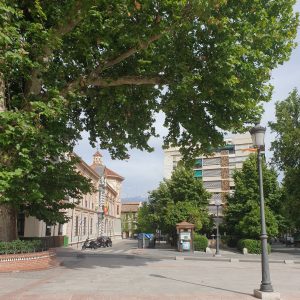 Rules:
Rules:
-Small businesses are allowed to reopen, as long as they observe social distances and safety precautions
-Restaurants and bar are allowed to open their outdoor seating, up to 50% capacity
-Social gatherings of up to 10 people are allowed, social distancing and precautions required
-Hotels and tourist accommodations can open, but public spaces must remain closed
-Cultural events can be help indoors (up to 30% of locale’s capacity) and outdoors (up to 300 people total)
-Face masks must be worn on public transit as well as in closed placed and outdoors when a two-meter distance cannot be maintained
-Timetables and distances for outdoor exercise remain in place
-Journeys in car for the above reasons or to reach a secondary residence are allowed WITHIN the same province
Further details: PDF here
Phase Two (The ‘Intermediate’ Stage)
There are no longer any provinces observing Phase Two. However, until June 21, 2020 the region of Madrid as well as four provinces of Castilla y León (Soria, Segovia, Ávila, and Salamanca) were still in Phase Two.
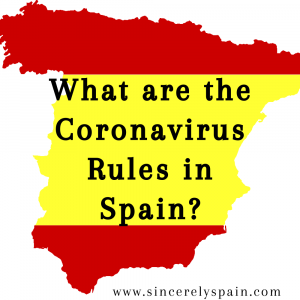 Rules:
Rules:
-Shops can open, regardless of their size, up to 40% capacity, allowing priority timetables for people over 65
-Social gatherings of up to 15 people are allowed, social distancing and precautions required
-Bars and restaurants can open indoor seating, up to 40% capacity, ideally by appointment only
-Hotels and tourist accommodations can open their public spaces, up to 30% capacity
-Cinemas, shopping malls, casinos, swimming pools, and bullrings are all allowed to re-open, each observing a different capacity cap between 30 and 50%
-Face masks must be worn on public transit as well as in closed placed and outdoors when a two-meter distance cannot be maintained
-Walks and physical exercise can take place outdoors, with no timetable or distance restrictions
Further details: PDF here
Phase Three (The ‘Last Stage’ of De-escalation)
Changes in this phase are mostly in terms of capacities allowed. Additionally, the regional government takes control over the decision-making in Phase Three, meaning that decisions such as how long the phase lasts do not require federal approval, as they did before. There are no longer any provinces observing Phase Two. Madrid and the aforementioned Castilla y León provinces opted to skip this Phase altogether.
 Rules:
Rules:
-Bars and restaurants are allowed to open their outdoor seating to 75% capacity
-All establishments that previously had to cap at 30% capacity can now open to 50% capacity
-Nightclubs and music bars can open to 30% but no dancing is allowed and dance floors should be used to provide additional seating
-Social gatherings of up to 20 people are allowed, social distancing and precautions required
-Beaches and communal areas like pools can re-open (depending on each region and province’s decision), social distancing and precautions required
-Face masks must be worn on public transit as well as in closed placed and outdoors when a two-meter distance cannot be maintained
-Walks and physical exercise can take place outdoors, with no timetable or distance restrictions
-Further details: PDF here
Phase Four (“The New Normality”)
While this phase is the final step of the De-escalation Plan, we are meant to view it not as another stage but as the new normal. The region of Galicia has been in “The New Normality” since June 15th. Catalonia (excluding Barcelona and Lleida), Cantabria, and País Vasco entered Phase Four at midnight on June 19th. Since June 21st, all of other regions have followed suit.
Rules:
-Face masks must be worn on public transit as well as in closed placed and outdoors when a 1.5-meter distance cannot be maintained
-All businesses, accommodations, and other establishments are allowed to open, given that they avoid crowds and allow for a 1.5-meter distance to be maintained at all times, other safety precautions should be taken as well
-Travel throughout the province, country, and internationally is allowed, in accordance with the guidelines set out by EASA (the European Union Aviation Safety Agency)
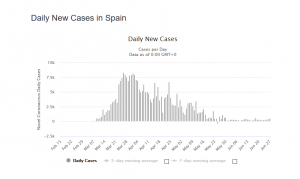 What does this actually look like now (as of June 29, 2020)?**
What does this actually look like now (as of June 29, 2020)?**
Businesses
Most businesses have re-opened and are operating as usual, although many precautions are being taken. Keep in mind that some business hours have been changed and some establishments are still functioning on an appointment-only system. In general, limits have been placed on how many people can enter at one time(because the 50% capacity cap is difficult for customers to measure, most small businesses have put up notice of only allowing one or two people at a time and many large businesses are stopping customers at the door after they reach their capacity).
In most cases masks are required to be worn, although this is not advertised at all establishments. Maintaining the 1.5 meter distance is still required, although in practice may not be observed. Larger shops have generally created a one-way system in order to avoid people entering and exiting head-on.
Our advice: Even if you don’t see a sign advising you as to rules of entry, we recommend you wear a mask whenever entering a closed space. If it is a small shop, try to make eye contact with the shop owner/attendant when entering. If there are any issues (such as too many people currently in the shop) they will be sure to alert you.
Travel Allowances
As of June 21, 2020 Spain’s borders were re-opened to international travels (the Spain-Portugal border has been postponed until July 1, 2020). However, we will go into the specifics of what this really means in our post on Thursday because there’s a lot to unpack in regards to this topic as well (pun intended).
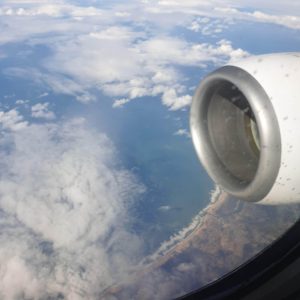 Use of Masks
Use of Masks
Face masks must be worn on all public transport, in all closed spaces, while traveling by car with people you do not live with, and outdoors when a 1.5-meter distance cannot be maintained. There is a 100 euro fine to enforce this, although as you can imagine, “when a 1.5-meter distance cannot be maintained” is a very slippery slope and we see a number of people not wearing masks while they are outdoors while many others are sporting their masks around their necks, chins, or other body parts.
There are a few legitimate exceptions to this rule. For instance, it does not apply to children under six or people with respiratory issues that could be aggravated by the use of a mask. The unspoken exception seems to be when sitting out on terrazas, as we would personally estimate that 90% of such people are not wearing masks. Of course, this makes sense as these people are there to eat or drink, activities that cannot take place with a mask on. However, since life in Spain is in the street, many of these people will stay for hours on end without their masks on, although they are occupying the same space as everyone who needs to walk past the establishment.
Our advice: If you are in Spain, we recommend you just follow the rule and wear your mask whenever you are in public. It might not be the thing everyone around you is doing, but it is the right thing to do for your own safety and for all of those you come into contact with.
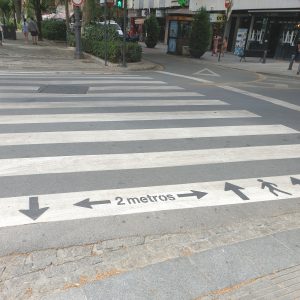 Social distancing
Social distancing
Depending on the phase of the de-escalation, a two-meter distance or a one-and-a-half-meter distance should be observed at all times. There are signs along many streets reminding pedestrians of this rule as well as sometimes indication of the direction of travel that should be adhered to on that side of the street (ie. heading north on the right side of the street and heading south on the left side).
Per our experience, only about 50% of people seem to bother to follow these rules. We certainly come across people who will go out of their way to give space to other pedestrians but we come across a nearly equal amount that stand and/or pass you at very close range. Unfortunately, these are often the same people not bothering to wear a mask. In everyone’s defense, it is not necessarily clear which direction of travel should be adhered to on certain streets and it’s not always possible to avoid going in the wrong direction if you need to get to a certain destination. All the same, the direction of travel is relatively ignored.
Our advice: Be sure to check up on the current Phase and distance required in the region you are currently in (this is a great English-language resource for that, see the list at the bottom of the article). If you notice signs about the direction of travel and are not stopping off somewhere on that block, take the extra ten seconds to cross over to the other side of the street. We can all do our small part to help reduce the spread of COVID-19.
We hope these explanations and descriptions of what we’re currently seeing in our corner of España have helped you understand the way in which Spain is approaching the Coronavirus pandemic. Please let us know if you have any further questions and we’ll do our best to get them answered!
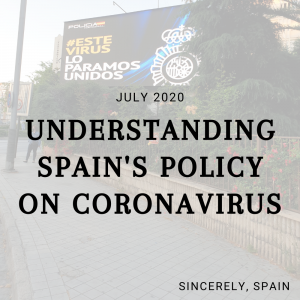 Sincerely,
Sincerely,
Spain
*This was the original rule. However, regions that were still in Phase Two on June 21, 2020 when the State of Alarm officially ended in Spain were allowed to skip Phase Three and enter into the ‘New Normality’ with the rest of the country.
**This information is from the perspective of Granada, Spain as we have only recently been allowed to leave the province and we have not yet taken advantage of that allowance.
Resources:
https://www.lamoncloa.gob.es/lang/en/gobierno/councilministers/Paginas/2020/20200428council.aspx
https://www.mscbs.gob.es/profesionales/saludPublica/ccayes/alertasActual/nCov-China/situacionActual.htm
https://www.spainenglish.com/2020/06/18/lifting-lockdown-spain-full-details-phases/
https://www.spainenglish.com/2020/05/24/face-masks-compulsory-spain/
https://www.rtve.es/noticias/20200622/mapa-desescalada-espana-fase-esta-tu-provincia/2013477.shtml




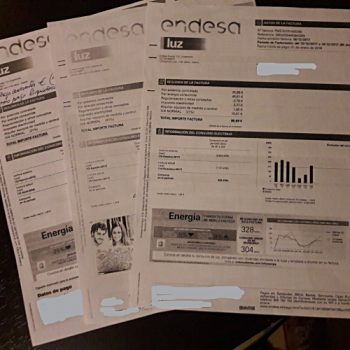
2 Comments
Jack
I would add that nearly all shops have a table with hand sanitizer just inside their door, you are expected to enter and then squirt some onto your hands before moving on. Anyone not doing this can be expected to be yelled at.
This gives you a chance to look for an information sheet showing the rules for that particular shop. Some say for example that you must wait to be allowed to begin to move through the shop. Others say do not touch anything inside the shop, ask if you wish to buy something.
Many shops seem to be asking for customers to pay using debit/credit cards, rather than in cash. Cash will always be allowed, but certainly shops seem much happier if you pay via a ‘contact-less’ card.
It will be very interesting to see how tourists adapt to these rules and new social norms as they come to Spain in the coming weeks and months.